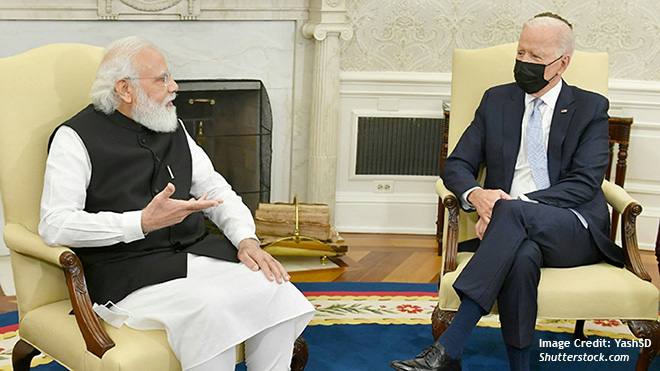Modi’s U.S. Visit to Harness Growing Trust

The India-U.S. bilateral relationship stands at a juncture, hitherto unseen, in terms of compatibility of interest and implementation. A broad positive arc guides the trajectory of the relationship amidst the shifting balance of power in the Indo-Pacific and the world at large. The upcoming state visit of India’s Prime Minister Narendra Modi to the United States is designed to reaffirm the growing trust in this relationship, albeit with divergences that are primarily structural in nature. Changing geopolitical circumstances have shaped the contours of this relationship, and intense negotiations in the post-Cold War era have reoriented mutual perceptions dramatically.
As Seema Sirohi writes in Friends with Benefits: The India-US Story, “Indians have made the Americans more sensitive to a different worldview, in which a country can stand alone for decades and, for instance, not sign a patently unfair and unequal treaty on nuclear weapons but maintain a clean record as if it were a signatory. The Americans have helped Indians break out of a few sacred ideological straitjackets by relentlessly pounding the table and projecting their views.” Although in many instances in the past and present, Washington would find New Delhi’s practice of strategic autonomy prickly, navigating 21st century complexities will require overcoming the “either you are with us, or against us” binary approach in U.S. foreign policy. The U.S.-India partnership presents a classic test case of stitching together an interest-based alignment, short of a formal alliance that suits the call of the uncertainties prevailing in current international affairs.
Defense Partnership Holds the Key
The recent visit of U.S. Secretary of Defense Lloyd J. Austin was a spadework for PM Modi’s visit later this month. Secretary Austin’s meeting with his Indian counterpart Defence Minister Rajnath Singh reaffirmed the centrality of the burgeoning India-U.S. defense partnership. More than any other sector, the defense partnership between the two countries has quantifiably grown by leaps and bounds. India’s traditional and continued dependence on Russia for its military hardware has not really impeded this development, given India’s desire to diversify its sources as well as explore new partners to move from a buyer-seller relationship towards co-development and co-production. After the signing of the foundational agreements, the militaries of the two countries enjoy growing interoperability, exhibited during the increasing sophistication of bilateral and multilateral military-to-military exercises. The willingness to recognize mutual concerns and find ways to address irritants is witnessed on both sides.
One of the achievements of the Austin-Singh meeting was the conclusion of a new Roadmap for U.S.-India Defense Industrial Cooperation. The focus is on upscaling technology sharing between the two countries, to improve India’s deterrent capabilities in the air, sea, and land domains. Areas marked for technology cooperation and co-production include “air combat and land mobility systems; intelligence, surveillance, and reconnaissance; munitions; and the undersea domain.” The vision of the India-U.S. Defense Technology and Trade Initiative (DTTI) to align Washington’s expectation of getting a bigger share of India’s defense imports and New Delhi’s intention to get access to more sophisticated defense technologies is gaining ground with each succeeding year.
Multi-Dimensional and Evolving Relations
The world is in quest for a new order that is more inclusive than the one witnessed in the previous century. From security in the maritime and continental expanse of the Indo-Pacific to the churning between developed and developing economies, from combating climate change to governing the use of new technologies, and the shift towards greener energy sources, a new order is taking shape replete with uncertainties. The growing profile of the India-U.S. relationship reflects a partnership that is germane to finding solutions to all military and non-military issues undercutting this phase of dynamism in international affairs. Unlike the Cold War of yore between the U.S. and the Soviet Union, the new great power rivalry between the U.S. and China is more comprehensive and more complex, igniting equally complex responses in the security and economic domains.
While a number of countries including India are extremely wary of China’s assertive military postures, across the Indo-Pacific, their interdependence with the Chinese economy has led to complex balancing behaviors. India’s multi-alignment strategy often puts it at odds with the U.S., since New Delhi finds it prudent to engage with countries like Russia that are America’s adversaries. On the one hand, India is deep in partnership with its Indo-Pacific partners in the Quad and has become more aligned with the strategic interests of the G7 countries. On the other hand, India is a cheerleader of the more diverse G20 grouping, and is equally pivotal in how groupings like the BRICS and SCO are emerging in their purpose and goals. While at the outset, India’s practice of autonomy in its foreign policy might seem antagonistic to its relationship with the U.S. but a sober recognition of such an approach will put the India-U.S. partnership on the path to weathering the storms of a multipolar world.
Over the years, the centrality of India in U.S. foreign policy and vice versa has acquired strong support cutting across partisan lines in both the democracies. Washington’s approach to alliances and partnerships is exhibiting a shift towards recognizing the intention of partner countries, particularly in Asia, to practice strategic autonomy as a means of navigating the complex U.S.-China great power rivalry. India’s own view of its dynamics with the West in general and the U.S. in particular has undergone a significant shift, reflected in both military and non-military sectors, and the growing compatibility in the quest for a “free, open and inclusive” rules-based order in the Indo-Pacific. As it always ought to have been, the India-U.S. relationship is truly multi-dimensional, and it is pertinent to see how these two democracies navigate the challenges of creating the architecture of a new world order pregnant with both opportunities and risks. Synergizing the India-U.S. bilateral understanding, with their respective approaches to multilateralism in global affairs, is the way ahead in this endeavor.